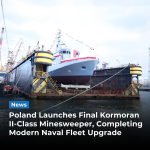- Reaction score
- 12,050
- Points
- 1,160
I hate to say it but he's not wrong. The type of MCM systems we currently have and on the way , you would just need a offshore supply vessel for the diving and MCM payloads. Much the same as HMCS Moresby and HMCS Anticosti were back the day although they mostly just fielded the mechanical systems to develop the skills before the Kingston Class were built.
I would prefer to have a purpose built MCM ship with at least a good degaussing system but the other solution would get you there though.View attachment 96796
Are there any Canadian yards building OSVs?
Based on USN experience then converting one for autonomous operation, once the software package firms up, takes less than 6 months. Leidos seems to be doing for ships what Rheinmetall's PATH is doing for conventional trucks.
But for Topshee to have OSVs to seize and convert he needs a readily available supply.





